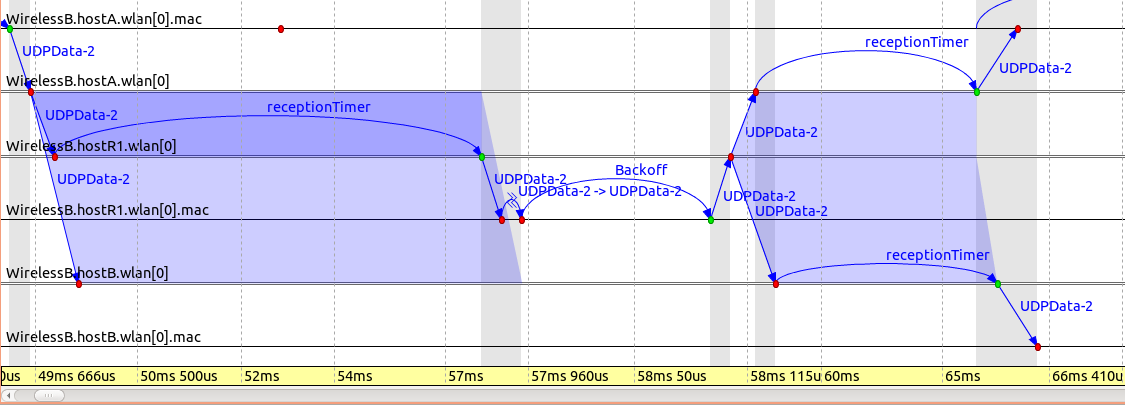Step 6. Using CSMA to better utilize the medium¶
Goals¶
In this step, we try to increase the utilization of the communication channel by choosing a medium access control (MAC) protocol that is better suited for wireless communication.
In the previous step, nodes transmitted on the channel immediately when they had something to send, without first listening for ongoing transmissions. This resulted in a lot of collisions and lost packets. We improve the communication by using the CSMA protocol, which is based on the “sense before transmit” (or “listen before talk”) principle.
CSMA (carrier sense multiple access) is a probabilistic MAC protocol in which a node verifies the absence of other traffic before transmitting on the shared transmission medium. CSMA has several variants; we’ll use CSMA/CA (where CA stands for collision avoidance). In this protocol, a node that has data to send first waits for the channel to become idle, and then it also waits for a random backoff period. If the channel is still idle during the backoff, the node can actually start transmitting. Otherwise, the procedure starts over, possibly with an updated range for the backoff period. We expect that the use of CSMA will improve throughput, as there will be fewer collisions, and the medium will be utilized better.
The model¶
To use CSMA, we need to replace AckingWirelessInterface in the hosts with
WirelessInterface. WirelessInterface is a generic NIC with both the radio
and the MAC module left open, so we specify UnitDiskRadio for its
radioType parameter, and CsmaCaMac for macType.
The CsmaCaMac module implements CSMA/CA with optional acknowledgments and a retry mechanism. It has a number of parameters for tweaking its operation. With the appropriate parameters, it can approximate basic 802.11b ad-hoc mode operation. Parameters include:
acknowledgments on/off
bit rate (this is used for both data and ACK frames)
protocol overhead: MAC header length, ACK frame length
backoff parameters: minimum/maximum contention window (in slots), slot time, maximum retry count
timing: interval to wait before transmitting ACK frame (SIFS) and before data frames in addition to the backoff slots (DIFS)
For now, we do not use an acknowledgment (sending of ACK packets), so we can see purely the effect of “listen before talk” and waiting a random backoff period before each transmission (this is the default behavior for the MAC). In the absence of ACKs, the MAC has to assume that all its transmissions are successful, so no frame is ever retransmitted.
[Config Wireless06]
description = Using CSMA to better utilize the medium
extends = Wireless05
*.host*.wlan[0].typename = "WirelessInterface"
*.host*.wlan[0].radio.typename = "UnitDiskRadio"
*.host*.wlan[0].mac.typename = "CsmaCaMac"
*.host*.wlan[0].mac.ackTimeout = 300us
*.host*.wlan[0].queue.typename = "DropTailQueue"
*.host*.wlan[0].queue.packetCapacity = -1
Results¶
The effect of CSMA can be seen in the animation below. The first two packets are sent by host A, and after waiting for a backoff period, host R1 retransmits both packets. This time, host B receives them correctly, because only host R1 is transmitting.
The following sequence chart displays that after receiving the UDPData-2 packet, host R1 transmits it after the backoff period timer has expired.
It is already apparent by watching the simulation that there are much fewer collisions this time. The numbers also confirm that CSMA has worked: nearly eight times as many packets are received by host B than in the previous step.
Number of packets received by host B: 1374
Sources: omnetpp.ini,
WirelessB.ned
